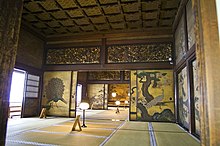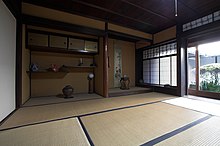Shoin-zukuri

Shoin-zukuri (書院造) is a style of Japanese residential architecture used in the mansions of the military, temple guest halls, and Zen
History

The foundations for the design of today's traditional Japanese residential houses with

The main reception room is characterized by specific features: a recessed alcove (

Conrad Totman argues that the development of the shoin-zukuri style was linked to a lumber scarcity, caused by excessive deforestation, which prompted the use of lower-quality, more abundant material. As larger, straight-grained trees became less accessible, "elegant wooden flooring gave way to crude wooden under-flooring that was concealed beneath tatami." Likewise, sliding wooden doors were replaced with fusuma, a lightweight combination of "stiff fabric or cardboard-like material pasted onto a frame made of slender wooden sticks," and shōji sliding panels served as a substitute for more elaborate paneled wooden doors.[12]
The simpler style used in the architecture of tea houses for the tea ceremony developed in parallel with shoin-zukuri. In the 16th century Sen no Rikyū established dedicated "grass hut" (草庵, sōan) style teahouses characterized by their small size of typically two to eight mat, the use of natural materials, and rustic appearance.[13] This teahouse style, exemplified by the Joan and Taian teahouses, was influenced by Japanese farmhouse style and the shoin style[14] featuring tatami matted floors, recessed alcoves (tokonoma) and one or more ante chambers for preparations.[14]
Sukiya-zukuri
By the beginning of the Edo period, the features of the shoin and the teahouse styles began to blend.[15] The result was an informal version of the shoin style called sukiya-zukuri (数寄屋造).[16][17] The sukiya-zukuri style has a characteristic decorative alcove and shelf, and utilizes woods such as cedar, pine, hemlock, bamboo, and cypress, often with rough surfaces including the bark.[17] Compared to the shoin style's, roof eaves in the sukiya style bend downward.[16] While the shoin style was suitable for ceremonial architecture, it became too imposing for residential buildings. Consequently, the less formal sukiya style was used for the mansions of the aristocracy and samurai after the beginning of the Edo period.[17][18]
See also
Notes
- ^ Kodansha Encyclopedia of Japan, entry for "shoin-zukuri".
- ^ Iwanami Kōjien (広辞苑) Japanese dictionary, 6th Edition (2008), DVD version
- ^ "Interview with Curator Matthew Welch - The Art of Asia - Japanese Audience Hall (Shoin)". archive.artsmia.org.
- ^ "Muromachi period". Encyclopedia Britannica. Encyclopedia Britannica Inc. Retrieved 17 December 2018.
- ^ a b c d e Young & Young 2007, p. 80
- ^ a b c Young & Young 2007, p. 81
- ^ JAANUS – Japanese Architecture and Art Net User System. Retrieved 2009-11-17.
- ^ Young & Young 2007, p. 79
- JAANUS – Japanese Architecture and Art Net User System. Retrieved 2009-11-17.
- ^ Nishi & Hozumi 1996, p. 76
- ^ Nishi & Hozumi 1996, p. 75
- ISBN 9781848851160.
- JAANUS – Japanese Architecture and Art Net User System. Retrieved 2009-11-17.
- ^ a b Young, Young & Yew 2004, p. 63
- ^ Young & Young 2007, p. 90
- ^ a b Young, Young & Yew 2004, p. 100
- ^ JAANUS – Japanese Architecture and Art Net User System. Retrieved 2009-11-17.
- ^ Nishi & Hozumi 1996, p. 78
References
- Nishi, Kazuo; Hozumi, Kazuo (1996) [1983]. What is Japanese architecture? (illustrated ed.). Kodansha International. ISBN 4-7700-1992-0. Retrieved 2009-11-11.
- Young, David; Young, Michiko (2007) [2004]. The art of Japanese architecture. Architecture and Interior Design (illustrated, revised ed.). Tuttle Publishing. ISBN 978-0-8048-3838-2. Retrieved 2009-11-11.
- Young, David; Young, Michiko Kimura; Yew, Tan Hong (2004). Introduction to Japanese architecture. Periplus Asian architecture (illustrated ed.). Tuttle Publishing. ISBN 0-7946-0100-6. Retrieved 2010-01-11.

